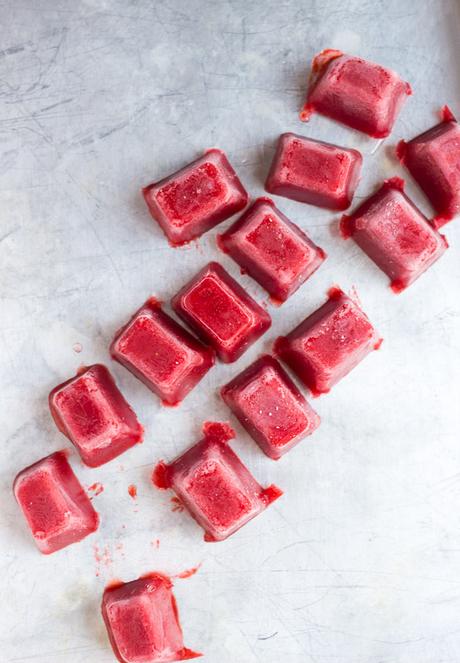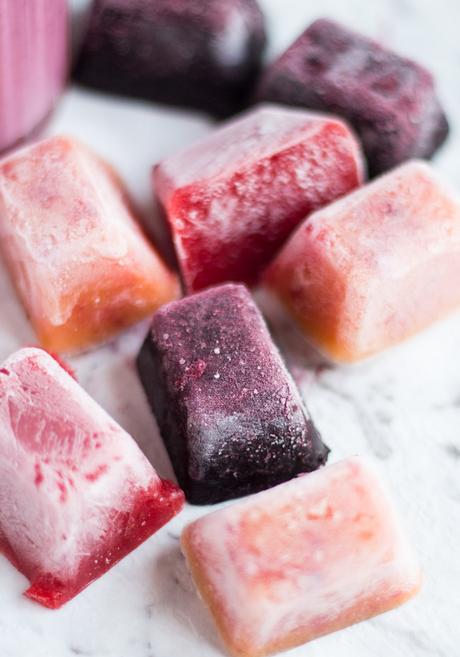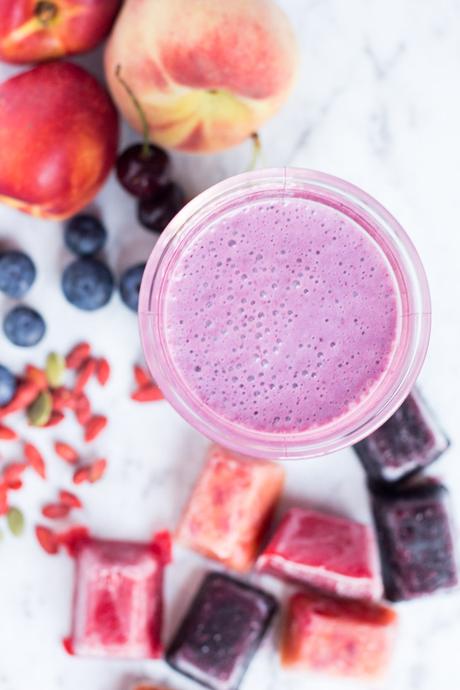
Sometimes it's the little things that excite me the most. Like homemade beef stock cubes, making my own yoghurt, or these DIY smoothie cubes. I've seen smoothie cubes sold for extortionate prices at the supermarket. I think I even bought a packet eons ago. There is, however, nothing quite as satisfying or simple as making your own.
If you are familiar with my ramblings, you will be aware of my proclivity for seasonal produce. This sees me constantly searching for new and interesting ways to preserve fruits and vegetables. My standard method for preserving fruit is to shallow freeze sliced fruit, which is then vacuum packed for use through the winter. Most of this fruit ends up in smoothies, with a small amount also finding its way into cakes, muffins and desserts.
It took the arrival of kilos of mulberries to make me reassess this position. Adopting my standard method, the mulberries would take up a large amount of space in the freezer, and as the stone fruit season has barely begun I didn't have much space to spare. The mulberries at the bottom of the bucket were sightly squished and already weeping juice, so I decided pureeing them might be a better option. And with that the smoothie cube was born.

Pureeing the mulberries, and freezing the puree in ice cube trays, reduced the space the berries took up in the freezer. However using the ice cube trays meant I could still remove small portions as required rather than defrosting larger containers of puree. So delighted have I been with this experiment, I've decided to adopt it as my preferred method for freezing summer fruits this season.
Interested in making your own smoothie cubes? This is all you need to do:
Gather Any Mix-Ins
Commercial smoothie cubes contain both a mixture of fruit and a selection of other additives such as goji berries, chia, linseed and sunflower seeds. If you prefer a particular smoothie flavour, adding these up front when making the cubes can save time. Other additions you might like to consider include nut butters, coconut butter, and spirulina or maca powder.
Puree The Fruit (or Vegetables)
This method is best suited to soft fruits that puree easily, such berries, peaches, nectarines, mangoes, melons and kiwi fruit. It is as simple as removing any pips, seeds, stones or skin, then dropping pieces of fruit into a food processor or blender. I have also pureed small amounts with a stick blender. Blend or process the fruit (with any optional additives) until the mixture is completely smooth. I have found that peaches and nectarines take a little longer to form a smooth puree than other fruits. You can also blitz different fruits together to make mixed smoothie cubes if you like, although I prefer to freeze the fruits individually.
Whilst I have only made fruit cubes, there is no reason the same method cannot be used to make vegetable cubes for green smoothies. Some vegetables, such as kale, may need a little water added to puree properly.
A quick tip: take care not to overfill the food processor or blender, as the machine action can force fruit puree out the top of the machine and all over your walls. Maybe.

Freeze The Puree
I use ice cube trays with lids, which make them easy to stack in the freezer. For large amounts of puree, I use a jug to fill the trays. For small amounts, I use a spoon. Freeze the puree until solid. The time taken for this will vary according to the size of the ice cube trays and the temperature of the freezer.
Store The Smoothie Cubes
Pure fruit cubes melt quickly, so ensure you are ready to package the cubes as soon as they are removed them from the tray. I tap the cubes out onto the counter, then quickly scoop them into plastic bags. If the cubes are to be used quickly (say within 3 months), then zip lock bags are perfect. For longer storage, I would recommend vacuum packing the cubes.

To Use The Smoothie Cubes
Drop 2 - 4 cubes into milk or kefir, together with any add-ins if they are not already in your smoothie cubes and your preferred sweetener (if any), and blitz. I use a hand held blender to make my smoothies, and find this powerful enough to smash the cubes.
Final Thoughts
I will continue to freeze trays of fruit for use in baking and desserts, however most of my fruit this summer will go into smoothie cubes. Smoothies aside, the cubes can also be used to make instant 'ice cream' in the Thermomix, to replace apple puree in some baking recipes, or even just as a quick snack. Now all I need to do is find another use for that extra freezer space.
